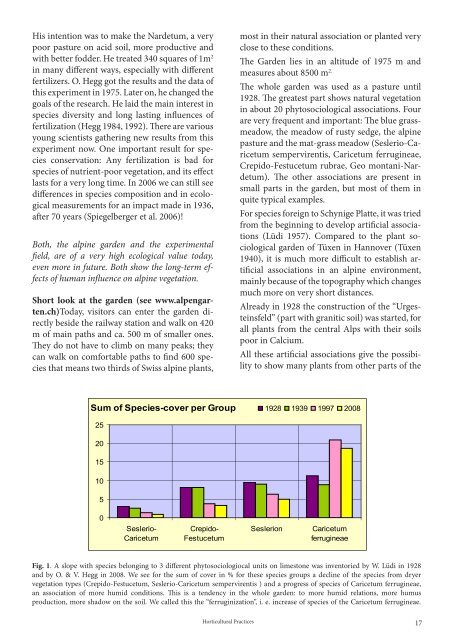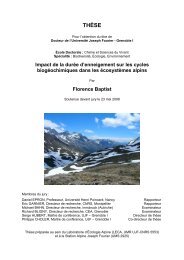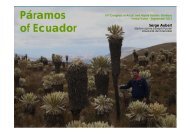2nd International Congress of Alpine and Arctic Botanical Gardens
2nd International Congress of Alpine and Arctic Botanical Gardens
2nd International Congress of Alpine and Arctic Botanical Gardens
Create successful ePaper yourself
Turn your PDF publications into a flip-book with our unique Google optimized e-Paper software.
His intention was to make the Nardetum, a very<br />
poor pasture on acid soil, more productive <strong>and</strong><br />
with better fodder. He treated 340 squares <strong>of</strong> 1m 2<br />
in many different ways, especially with different<br />
fertilizers. O. Hegg got the results <strong>and</strong> the data <strong>of</strong><br />
this experiment in 1975. Later on, he changed the<br />
goals <strong>of</strong> the research. He laid the main interest in<br />
species diversity <strong>and</strong> long lasting influences <strong>of</strong><br />
fertilization (Hegg 1984, 1992). There are various<br />
young scientists gathering new results from this<br />
experiment now. One important result for species<br />
conservation: Any fertilization is bad for<br />
species <strong>of</strong> nutrient-poor vegetation, <strong>and</strong> its effect<br />
lasts for a very long time. In 2006 we can still see<br />
differences in species composition <strong>and</strong> in ecological<br />
measurements for an impact made in 1936,<br />
after 70 years (Spiegelberger et al. 2006)!<br />
Both, the alpine garden <strong>and</strong> the experimental<br />
field, are <strong>of</strong> a very high ecological value today,<br />
even more in future. Both show the long-term effects<br />
<strong>of</strong> human influence on alpine vegetation.<br />
Short look at the garden (see www.alpengarten.ch)Today,<br />
visitors can enter the garden directly<br />
beside the railway station <strong>and</strong> walk on 420<br />
m <strong>of</strong> main paths <strong>and</strong> ca. 500 m <strong>of</strong> smaller ones.<br />
They do not have to climb on many peaks; they<br />
can walk on comfortable paths to find 600 species<br />
that means two thirds <strong>of</strong> Swiss alpine plants,<br />
Sum <strong>of</strong> Species-cover per Group<br />
25<br />
20<br />
15<br />
10<br />
5<br />
0<br />
Seslerio-<br />
Caricetum<br />
Crepido-<br />
Festucetum<br />
most in their natural association or planted very<br />
close to these conditions.<br />
The Garden lies in an altitude <strong>of</strong> 1975 m <strong>and</strong><br />
measures about 8500 m2. The whole garden was used as a pasture until<br />
1928. The greatest part shows natural vegetation<br />
in about 20 phytosociological associations. Four<br />
are very frequent <strong>and</strong> important: The blue grassmeadow,<br />
the meadow <strong>of</strong> rusty sedge, the alpine<br />
pasture <strong>and</strong> the mat-grass meadow (Seslerio-Caricetum<br />
sempervirentis, Caricetum ferrugineae,<br />
Crepido-Festucetum rubrae, Geo montani-Nardetum).<br />
The other associations are present in<br />
small parts in the garden, but most <strong>of</strong> them in<br />
quite typical examples.<br />
For species foreign to Schynige Platte, it was tried<br />
from the beginning to develop artificial associations<br />
(Lüdi 1957). Compared to the plant sociological<br />
garden <strong>of</strong> Tüxen in Hannover (Tüxen<br />
1940), it is much more difficult to establish artificial<br />
associations in an alpine environment,<br />
mainly because <strong>of</strong> the topography which changes<br />
much more on very short distances.<br />
Already in 1928 the construction <strong>of</strong> the “Urgesteinsfeld”<br />
(part with granitic soil) was started, for<br />
all plants from the central Alps with their soils<br />
poor in Calcium.<br />
All these artificial associations give the possibility<br />
to show many plants from other parts <strong>of</strong> the<br />
1928 1939 1997 2008<br />
Seslerion Caricetum<br />
ferrugineae<br />
Fig. 1. A slope with species belonging to 3 different phytosociologiocal units on limestone was inventoried by W. Lüdi in 1928<br />
<strong>and</strong> by O. & V. Hegg in 2008. We see for the sum <strong>of</strong> cover in % for these species groups a decline <strong>of</strong> the species from dryer<br />
vegetation types (Crepido-Festucetum, Seslerio-Caricetum sempervirentis ) <strong>and</strong> a progress <strong>of</strong> species <strong>of</strong> Caricetum ferrugineae,<br />
an association <strong>of</strong> more humid conditions. This is a tendency in the whole garden: to more humid relations, more humus<br />
production, more shadow on the soil. We called this the “ferruginization”, i. e. increase <strong>of</strong> species <strong>of</strong> the Caricetum ferrugineae.<br />
Horticultural Practices 17




